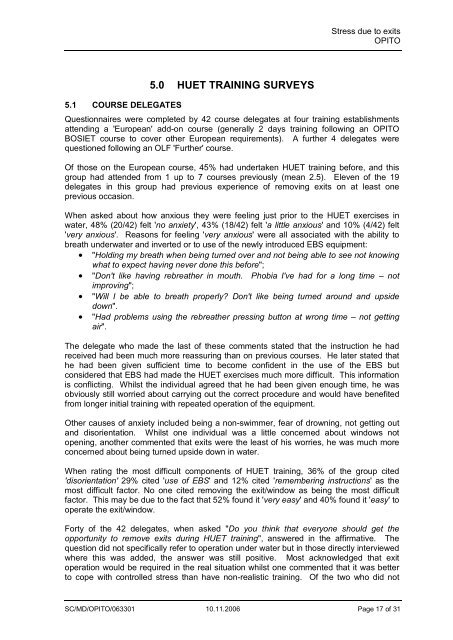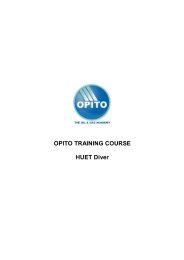Stress levels associated with huet - Opito
Stress levels associated with huet - Opito
Stress levels associated with huet - Opito
You also want an ePaper? Increase the reach of your titles
YUMPU automatically turns print PDFs into web optimized ePapers that Google loves.
5.1 COURSE DELEGATES<br />
5.0 HUET TRAINING SURVEYS<br />
<strong>Stress</strong> due to exits<br />
OPITO<br />
Questionnaires were completed by 42 course delegates at four training establishments<br />
attending a 'European' add-on course (generally 2 days training following an OPITO<br />
BOSIET course to cover other European requirements). A further 4 delegates were<br />
questioned following an OLF 'Further' course.<br />
Of those on the European course, 45% had undertaken HUET training before, and this<br />
group had attended from 1 up to 7 courses previously (mean 2.5). Eleven of the 19<br />
delegates in this group had previous experience of removing exits on at least one<br />
previous occasion.<br />
When asked about how anxious they were feeling just prior to the HUET exercises in<br />
water, 48% (20/42) felt 'no anxiety', 43% (18/42) felt 'a little anxious' and 10% (4/42) felt<br />
'very anxious'. Reasons for feeling 'very anxious' were all <strong>associated</strong> <strong>with</strong> the ability to<br />
breath underwater and inverted or to use of the newly introduced EBS equipment:<br />
• "Holding my breath when being turned over and not being able to see not knowing<br />
what to expect having never done this before";<br />
• "Don't like having rebreather in mouth. Phobia I've had for a long time – not<br />
improving";<br />
• "Will I be able to breath properly? Don't like being turned around and upside<br />
down".<br />
• "Had problems using the rebreather pressing button at wrong time – not getting<br />
air".<br />
The delegate who made the last of these comments stated that the instruction he had<br />
received had been much more reassuring than on previous courses. He later stated that<br />
he had been given sufficient time to become confident in the use of the EBS but<br />
considered that EBS had made the HUET exercises much more difficult. This information<br />
is conflicting. Whilst the individual agreed that he had been given enough time, he was<br />
obviously still worried about carrying out the correct procedure and would have benefited<br />
from longer initial training <strong>with</strong> repeated operation of the equipment.<br />
Other causes of anxiety included being a non-swimmer, fear of drowning, not getting out<br />
and disorientation. Whilst one individual was a little concerned about windows not<br />
opening, another commented that exits were the least of his worries, he was much more<br />
concerned about being turned upside down in water.<br />
When rating the most difficult components of HUET training, 36% of the group cited<br />
'disorientation' 29% cited 'use of EBS' and 12% cited 'remembering instructions' as the<br />
most difficult factor. No one cited removing the exit/window as being the most difficult<br />
factor. This may be due to the fact that 52% found it 'very easy' and 40% found it 'easy' to<br />
operate the exit/window.<br />
Forty of the 42 delegates, when asked "Do you think that everyone should get the<br />
opportunity to remove exits during HUET training", answered in the affirmative. The<br />
question did not specifically refer to operation under water but in those directly interviewed<br />
where this was added, the answer was still positive. Most acknowledged that exit<br />
operation would be required in the real situation whilst one commented that it was better<br />
to cope <strong>with</strong> controlled stress than have non-realistic training. Of the two who did not<br />
SC/MD/OPITO/063301 10.11.2006 Page 17 of 31




